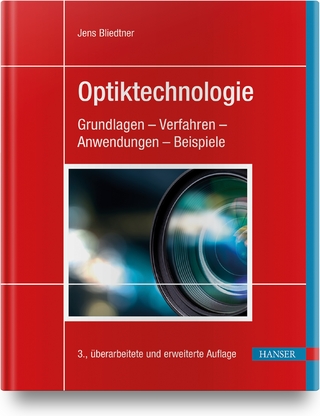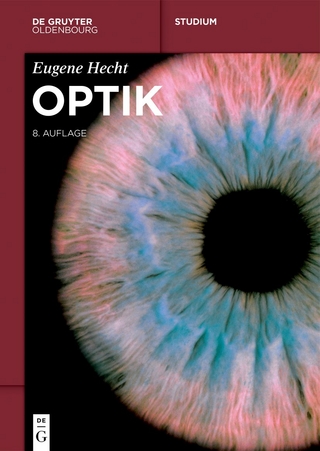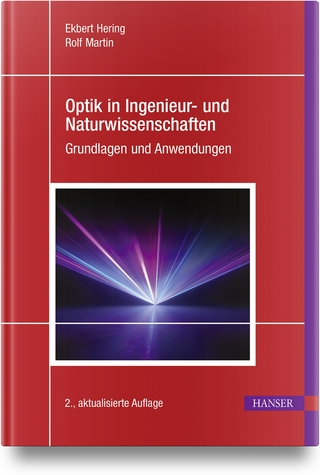
High Intensity Laser Matter Interaction
Wiley-VCH Verlag GmbH & Co. KGaA
978-3-527-41236-5 (ISBN)
- Titel wird leider nicht erscheinen
- Artikel merken
Malte C. Kaluza holds a Chair for experimental physics with the specialization of relativistic laser physics at the Friedrich-Schiller-University in Jena, Germany. After completing his Diploma and PhD in physics at the Technical University in Munich and at the Max-Planck-Insitute of Quantum Optics in Garching, he joined the plasma physics group at Imperial College in London before returning to Germany where he started as a junior professor in Jena. Malte Kaluza has been working on most of the major high-power laser systems in Europe being involved in numerous experiments on laser-driven particle acceleration.
1. Interaction of single electrons with electromagnetic radiation at relativistic intensities
a. description of the laser field in vacuum: E(r,t), B(r,t), A(r,t) plane wave propagation, description of laser focusing
b. electron's equation of motion: classic vs. fully relativistic solution
c. two invariants of the relativistic electron motion
d. Lawson-Woodward theorem
e. ponderomotive potential, ponderomotive scattering
f. current overview over first experimental results, historic development
2. Basics of plasma physics
a. definition and properties of plasmas in general:
quasi neutrality, Debye-shielding, plasma oscillations, plasma frequency
b. plasma formation/ionization mechanisms involving electromagnetic radiation:
multi-photon ionization, tunnel ionization, over-the-barrier ionization
c. other relevant ionization mechanisms: electron impact ionization, collisions,.
d. thermal effects in a plasma: pressure, (local) thermal equilibrium,.
3. Numerical description of laser-generated plasmas
a. Particle-In-Cell (PIC) codes: multi-dimensionality, boosted-frame-description, limitations of this approach
b. magneto-hydrodynamic (MHD) codes
c. combination of both types: hybrid-code approaches
4. Classic, non-linear, and relativistic optics in plasmas
a. classic plasma effects:
light propagation in plasmas, phase and group velocity, refractive index
b. non-linear plasma effects:
self-phase modulation of light pulses, ionization defocusing, self steepening of laser-pulses, "photon acceleration"
c. relativistic plasma effects: relativistic and ponderomotive self-focusing, formation of plasma channels
5. Waves in a plasma
a. derivation of electron-plasma wave equation
b. linear and non-linear solution
c. derivation of associated electric and magnetic fields
d. electron-plasma wave excitation by laser or particle beams
e. electron-plasma wave evolution
f. electron-plasma and light-wave mixing: Raman scattering
g. ion-acoustic wave generation and evolution
h. coupling between light and ion-acoustic waves: Brillouin scattering
i. experimental investigations of plasma waves, relevance for laser-plasma coupling
6. Laser-driven electron acceleration in plasmas
a. motivation/comparison to conventional accelerator techniques
b. ponderomotive acceleration
c. direct laser acceleration (DLA)
d. plasma wake field acceleration
i. bubble-acceleration
ii. dephasing, pump depletion,
e. characterizing quantities of relativistic electron pulses: duration, source size, energy spectrum, emittance, peak current - comparison between different electron acceleration mechanisms
7. Laser-driven ion acceleration
a. self-similar solution: thermal ion acceleration
b. target normal sheath acceleration (TNSA): basic principle, multi-dimensional effects, adiabatic cooling, multi-species ion acceleration
c. modified TNSA: ion acceleration from mass-limited targets, micro-structured targets
d. radiation-pressure acceleration: theory and experimental realization
e. characterizing quantities of (laser-driven) ion pulses and experimental ways to measure them
f. application of laser-generated ion pulses: fast ignition of inertial confinement fusion, radio therapy,
8. Secondary radiation sources based on laser-accelerated electron pulses
a. wigglers vs. undulators ("classical" description)
b. laser-generated plasma channel as a wiggler for laser-driven electrons
c. generation of betatron radiation (also as a means of characterizing electron bunches)
d. radiation-pulse generation using external magnetic devices
e. Thomson and Compton backscattering of photons off relativistic electrons
9. High-harmonic generation (HHG) from solid targets
a. coherent wake emission (CWE)
b. relativistically oscillating mirror (ROM)
c. scaling to higher laser intensities
10. Probing of laser-generated plasmas
a. interferometry, shadowgraphy, Schlieren technique: for plasma density distributions
b. scattering techniques (Brillouin, Thomson,.): for plasma temperature distribution
c. polarimetry/Faraday effect: magnetic field distributions
d. x-ray probing and emission: Stark effect, broadening of characteristic line-emission, field-induced emission of "forbidden" lines,.
11. Laser-based neutron sources
12. Laser-based x-ray sources
13. High-power laser technology relevant for relativistic laser-plasma interactions
a. Ti:Sapphire laser technology: advantages vs. challenges, high repetition rate and short pulse duration but limited pulse energy
b. Nd:glass systems: high pulse energy @ low repetition rates and longer pulse duration
c. diode-pumping, combination of both advantages
d. fiber-laser based approaches, high repetition rate (10-100 kHz) + coherent combination
e.diagnostic techniques for laser-pulse characterization
f.laser pulse improvements: contrast, focusability, peak power, repetition rate, compactness of laser systems,.
| Sprache | englisch |
|---|---|
| Maße | 170 x 240 mm |
| Themenwelt | Naturwissenschaften ► Physik / Astronomie ► Optik |
| Schlagworte | Chemie • Chemistry • materials characterization • Materials Science • Materialwissenschaften • Optics & Photonics • Optik u. Photonik • Physics • Physik • Plasma physics • Plasmaphysik • spectroscopy • Spektroskopie • Werkstoffprüfung |
| ISBN-10 | 3-527-41236-0 / 3527412360 |
| ISBN-13 | 978-3-527-41236-5 / 9783527412365 |
| Zustand | Neuware |
| Haben Sie eine Frage zum Produkt? |
aus dem Bereich


